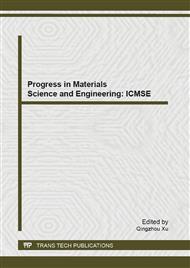[1]
Ogasawara, Meitoku. Aluminum Soldering Technology - Progress and history of non corrosion flux soldering process[J]. Journal of Light Metal Welding and Construction, 2012, 50(1): 2-7.
Google Scholar
[2]
Moller, Craig, Grann, Jim. Vacuum aluminum soldering - What matters most[J]. International Soldering and Soldering Conference, 2012, 244-251.
Google Scholar
[3]
Ari M, Saatçi B, Gündüz M, Payveren M, Durmus S. Thermo-electrical characterization of Sn–Zn alloys. Mater Charact 2008; 59: 757-63.
DOI: 10.1016/j.matchar.2007.06.007
Google Scholar
[4]
Lan GA, Yang CW, Lui TS, Chen LH. The Weibull statistical analysis for evaluating microstructural effects on electrification–fusion phenomenon of Sn- xZn alloys. J Alloys Compd 2009; 475: 294-9.
DOI: 10.1016/j.jallcom.2008.08.022
Google Scholar
[5]
Katsuaki Suganuma, Kuen-Soo Kim. Sn-Zn low temperature solder[J]. Mater Electron , 2007, 18: 121-127.
Google Scholar
[6]
Toru Nagaoka, Yoshiaki Morisada, Masao Fukusumi, Tadashi Takemoto. Joint strength of aluminum ultrasonic soldered under liquidus temperature of Sn-Zn hypereutectic solder[J]. Journal of Materials Processing Technology, 2009, 209: 5054-5059.
DOI: 10.1016/j.jmatprotec.2009.02.003
Google Scholar
[7]
GB11364-89, the standard test method on wettability estimation of solders (the National Standard of China, 1989).
Google Scholar
[8]
Xia Jin, Changjin Yang, Baoxiang Liu. Development of the fluxes for aluminum soldering[J]. Electronic technology, 2008, 29(2): 112-115.
Google Scholar
[9]
Zhi Wang, Hongyang Wang, Liming Liu. Study on low temperature soldering of magnesium alloy to aluminum alloy using Sn-xZn solders[J]. Materials and Design, 2012, 39: 14-19.
DOI: 10.1016/j.matdes.2012.02.021
Google Scholar
[10]
Christoph Luef, Aloke Paul, Jiri Vizdal, Ales Kroupa, Alexander Kodentsov, and Herbert Ipser. Thermodynamic Properties and Melting Behavior of Bi-Sn-Zn Alloys[J]. Monatshefte fur Chemie, 2006, 137: 381-395.
DOI: 10.1007/s00706-005-0457-x
Google Scholar
[11]
K. Bukat, Z. Moser, W. Gasior, M. Koscielski, J. Pstrus, Trends in wettability studies of Pb-free solders. Basic and application. Part P . Relation between surface tension, interfacial tension and wettability of lead-free Sn-Zn and Sn-Zn-Bi-Sb alloys. Arch. Metall. Mater. 53(4), 1065-1074 (2008).
DOI: 10.1108/09540911011054145
Google Scholar
[12]
J. Zhou, D. Huang, Y.L. Fang, F. Xue, Investigation on properties of Sn-8Zn-3Bi lead-free solder by Nd addition. J. Alloy. Compd. 480(2), 903-907 (2009).
DOI: 10.1016/j.jallcom.2009.02.064
Google Scholar
[13]
W.X. Chen, S.B. Xue, H. Wang, Y.H. Hu, Wettability of lead-free solders of Sn-Zn-xAl. Trans. China Weld. Inst. 29(8), 37-40 (2008).
Google Scholar
[14]
K. Bukat, J. Sitek, R. Kisiel, Z. Moser, W. Gasior, Evaluation of the influence of Bi and Sb additions to Sn-Ag-Cu and Sn-Zn alloys on their surface tension and wetting properties using analysis of variance-ANOVA. Solder. Surf. Mt. Technol. 20(4), 9-19 (2008).
DOI: 10.1108/09540910810902660
Google Scholar
[15]
Junxiang Jiang, Jae-Ean Lee, Keun-Soo Kim, Katsuaki Suganuma. Oxidation behavior of Sn-Zn solders under high-temperature and high-humidity conditions[J]. Journal of Alloys and Compounds , 2008, 462: 244-251.
DOI: 10.1016/j.jallcom.2007.08.007
Google Scholar
[16]
H. Wang, S.B. Xue, W.X. Chen, Effects of Al addition on corrosion resistance and high-temperature oxidation resistance of Sn-9Zn lead-free solder. Electr. Weld. Mach. 38(9), 61-64 (2008).
Google Scholar


